How to draw giraffes.
With its graceful walk and gangly, long neck, giraffes can be tricky to draw accurately. But with these tips and a step-by-step drawing tutorial, you can bring your giraffe sketches to life.
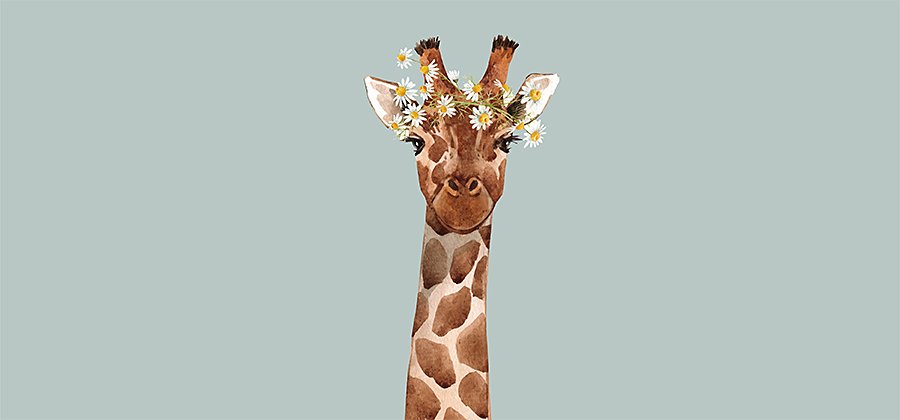
How drawing giraffes can stretch your skills.
As the world’s tallest living terrestrial animal, giraffes are iconic. These herbivores wander the grasslands in small groups, searching for greens and evading predators. While the life of a giraffe may seem relatively uncomplicated, that’s not the case when it comes to sketching them. With their exaggerated proportions, “giraffes are fascinating animals, but they’re fairly complex to draw,” says illustrator Terryl Whitlatch.
Before you sketch a giraffe, do some research. “It’s always helpful to study the skeletal structures and the defining shapes that the animal is made of,” notes illustrator and art director Alex Braun. When you understand how their ears are shaped, how their knees bend, and the slope of their spine, you’re better equipped to draw a graceful, eye-catching giraffe.
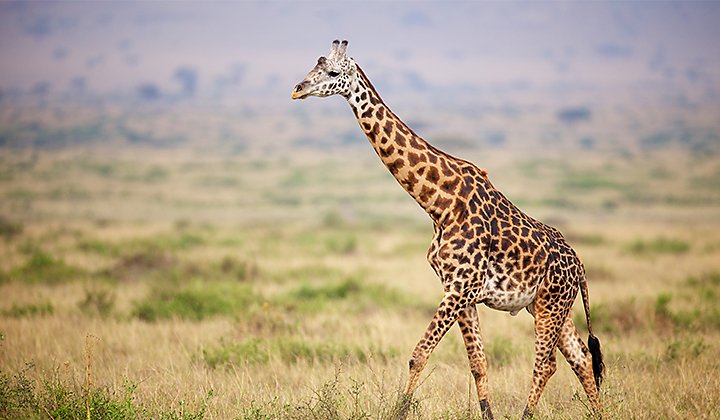
Start with these simple steps.
1. Plan your drawing.
When it comes to reference photos, remember “there are several different subspecies of giraffe, and each one has its own special spot pattern,” says Whitlatch. For example, the pattern on the Rothschild’s giraffe is quite different from the marks on the Masai giraffe. If you want to draw a cute cartoon giraffe, these details are less important. But if you want to create a realistic drawing, the details are important.
2. Break down the basic shapes.
Before you get to the details, you need to sketch a basic underdrawing to get the lines of your giraffe shape right. “I always just simplify the body into basic shapes,” explains Whitlatch “Be methodical and notice how sloped the back is, for example. Or how its front legs are somewhat longer and taller than its hind legs.” Use circles and oval shapes to block in the major parts of the giraffe. See where the joints connect, and notice the thickness of the giraffe’s neck. If you analyze these simple shapes, you’re more likely to get an accurate animal drawing.
3. Polish the shapes and silhouette.
“Once you’ve got that overall structure down, you can refine the drawing,” says Whitlatch. Perfect those curved lines and define the muscles. Remember, while they can look tall and spindly, giraffes are actually big, sturdy mammals. Help your drawing communicate that density by adding some light shading to show shadow and dimension.
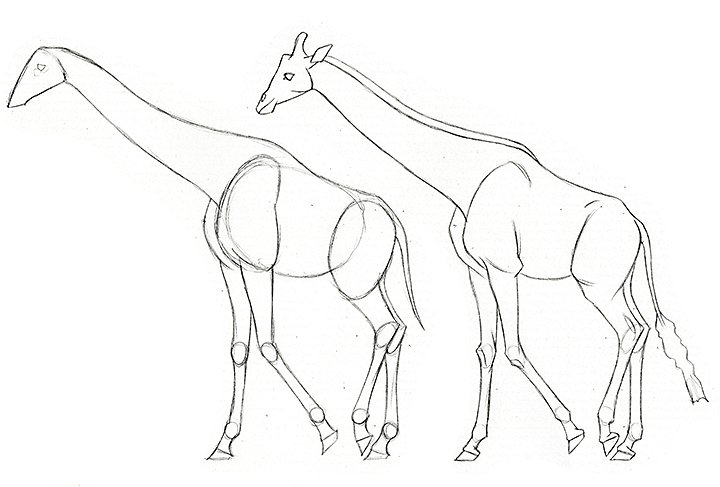
Image by Terry Whitlatch
4. Draw the spots.
Just like a cheetah, giraffes have distinctive spots. Outline the spots and draw them so they wrap around the giraffe’s body. This will help give your drawing more dimension. Check your reference photos as you go, and be sure to alter and adjust the size and shape of the spots. “The pattern starts to fade as you move down the giraffe’s leg, and the spots get smaller and smaller until they almost disappear,” says Braun. If you’re working digitally, put the spots on a new layer so you can color and edit them separately from the rest of the giraffe.
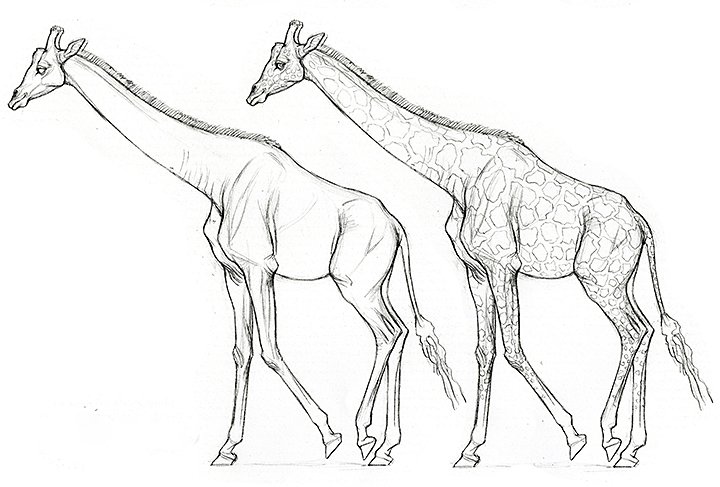
Image by Terry Whitlatch
5. Add a base color.
Use light yellow or beige to color the base of your giraffe’s coat. If you’re working digitally, use clipping masks and soft brushes to achieve gentle gradients that don’t spill into the background of the drawing. Keep your light source in mind and add lighter colors in areas of highlight.
Give your giraffe its iconic print by coloring in the spots with a dark reddish brown. With the spots on a separate layer in your digital drawing, you can use clipping masks to add gradients to the markings, while leaving the rest of your drawing untouched. Keep in mind that some giraffes have fewer or lighter spots on their face.
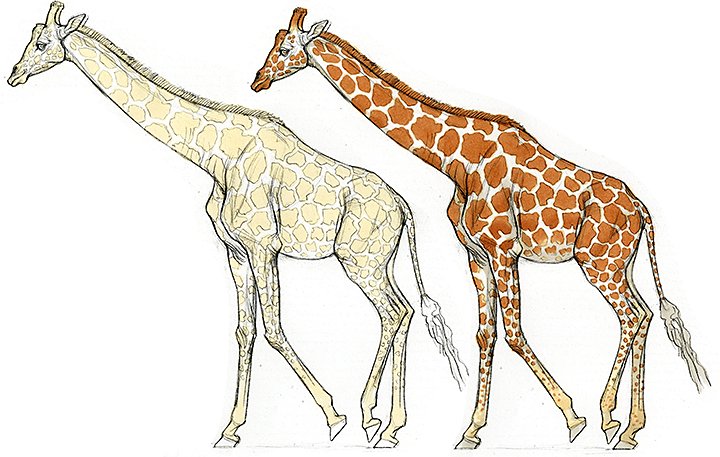
Image by Terry Whitlatch
7. Give it some detail.
With the majority of the colors added, go in and add details to the giraffe’s head, mane, tail, and hooves. “Use soft brushes to create separate gradients and shade the mouth, the top of the head, and the horns,” says Braun. On top of that layer, you can draw in the mouth, eyes, and snout.
“I always like to change the shading color to give it a little more life. I try to stay away from grays or blacks, just because it can make animals look kind of dull and makes the colors less vibrant,” explains Braun. “I also use a very soft brush to highlight the giraffe’s face to show where light is coming from.” Use those soft brushes and washes to create definition in the head, neck, and hip joints. With just some simple shading you can transform a flat sketch into a lifelike drawing.
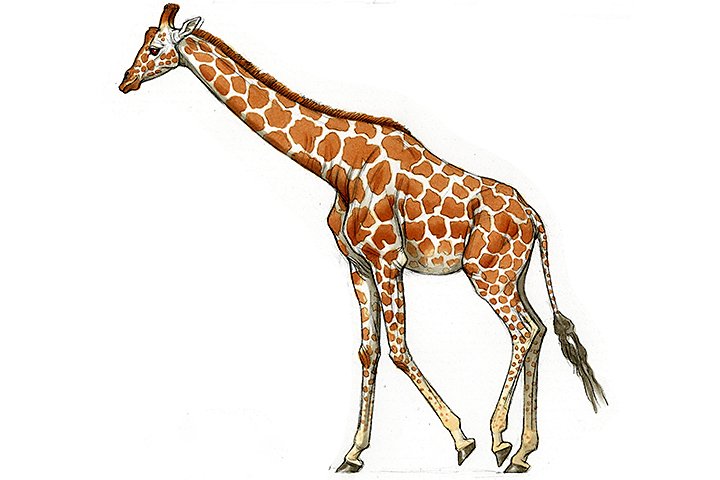
Image by Terry Whitlatch
Find inspiration in other artists.
Take a look at giraffes that talented artists are creating on Behance.
- Get an up close and personal view with this realistic giraffe portrait made using Adobe Fresco.
- Take a different approach and sketch your own cartoon character, like this cute giraffe riding a moped scooter.
- Draw inspiration from children’s books like this artist did, and make a simplified, brightly colored giraffe.
- After visiting a local zoo, this artist created a stylized illustration of a giraffe face.
Perfect your drawings digitally.
Take your giraffe drawings to another level and achieve just the look you’re going for with Fresco. Explore live brushes that work like real watercolors or oil paints and vector brushes that can scale to any size. Use multiple layers to keep the spots separate from the body of your giraffe, and apply gentle gradients without smudging your outlines or altering your background.
Contributors
You might also be interested in…
Learn how to draw horses.
Discover tips to take on the challenge of drawing these big, beautiful creatures.
How to draw birds of any feather.
Learn the basics of drawing birds digitally with this step-by-step tutorial.
How to draw a wolf.
Capture the wild spirit of the wolf with these drawing tips.
How to become a professional illustrator.
Get tips on portfolio creation and art presentation to help you kick off a new career.



